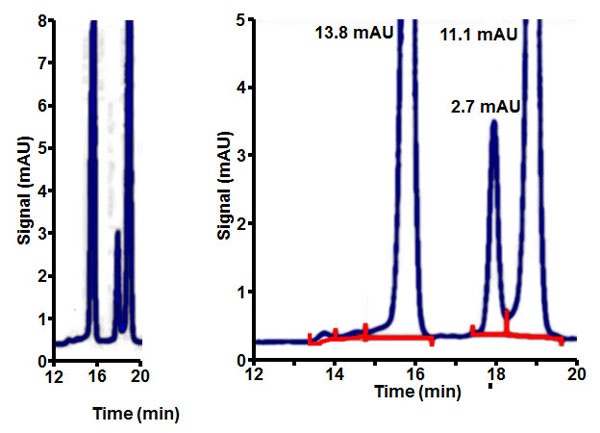A question that commonly arises in my Master Classes is the proper technique to integrate chromatograms where the peaks are not fully baseline resolved. For this, I most commonly draw on what I call the 10% Rule. This applies when a minor peak is partially merged with a major one. If the height of the minor peak is <10% of the height of the major peak, a skim is the appropriate integration technique. If the minor peak is >10% of the major peak, a perpendicular drop is the best technique.
In the left-hand chromatogram of Figure 1, we have a good example of where integration decisions need to be made. It is best to expand the chromatogram for easier viewing, as in the right-hand version. First consider the two small peaks that are eluted on the front edge of the 15.75-min peak. These are hardly visible in the left-hand chromatogram, but can be distinguished on the right-hand one. These obviously are <<10% of the height of the 15.75-min peak, so skimming is the appropriate integration technique. The vertical lines indicate where the data system picked the start and stop points on each peak. Just draw a new baseline under each of these peaks; do your best to follow the slant of the overall baseline. The data system will then calculate the area between the chromatogram tracing and the manually drawn baseline. Alternatively, peak height will be determined from the highest point on the peak to a point on the new baseline directly below.

Figure 1
Next comes the integration of the 15.75-min peak. The point to start the integration is somewhat subject to the operator’s decision, but whatever starting and ending points are chosen, these should be consistency between sample chromatograms and reference standards. In the present example, the decision was made to start after the second minor peak and draw the new baseline to the end point. It can be argued that the starting point should originate at the left side of the first minor peak where the flat baseline begins to rise. Or, if it is known that the bump on the front of the 15.75-min peak is another minor peak, perhaps a perpendicular drop at about 15.1 min might be chosen so as to eliminate the extra area from the interference. Such decisions have to be made based on the available information, and do not necessarily follow a fixed definition. In this case, any of the three choices is unlikely to have a major impact on integration, because the overall area under the 15.75-min peak won’t vary much. An alternative would be to quantify by peak height, where the start point would have even less influence on the results.
The peak at 17.9 min that is partially resolved from the 18.8-min peak is much easier to deal with. In this case, its height is 2.7/11.1, which is >10% of the 18.8-min peak, so a perpendicular drop is appropriate. A baseline is drawn between the beginning of the minor peak and the end of the major peak, then a perpendicular drop is made at the low point of the valley between the two peaks and the baseline.
It should be noted that the 10% rule is not set in stone, but is a consensus based on years of experience by many chromatographers. And, as might be expected, errors in integration will be the largest near the 10% cutoff point. The decision about how to integrate a peak should be based on rules of thumb, in addition to other knowledge about the peaks. Is there information available relative to minor background interferences? Are there data from the method validation that supports a higher quality of data using one integration technique vs. another? The choice of integration technique still is the decision of the operator, but it should not be an arbitrary one.
This blog article series is produced in collaboration with John Dolan, best known as one of the world’s foremost HPLC troubleshooting authorities. He is also known for his research with Lloyd Snyder, which resulted in more than 100 technical publications and three books. If you have any questions about this article send them to TechTips@sepscience.com




